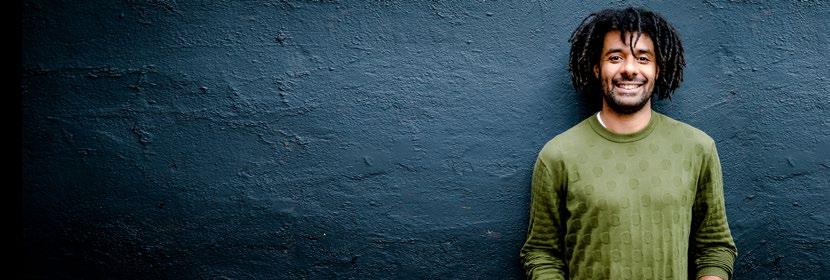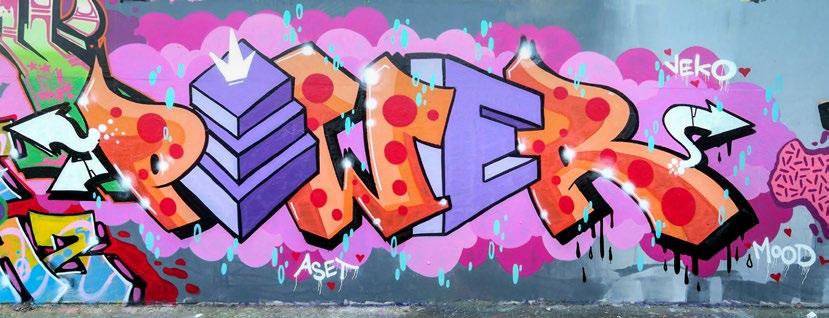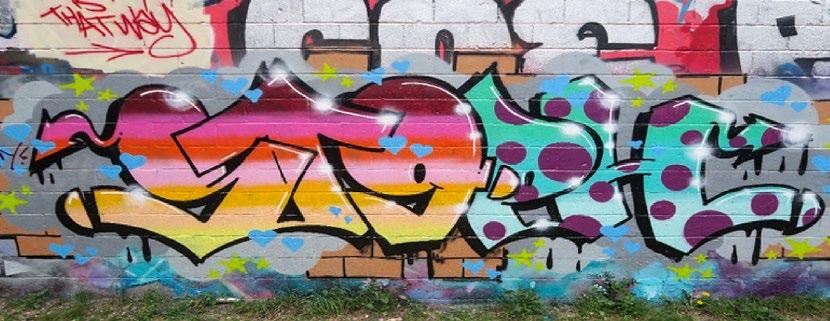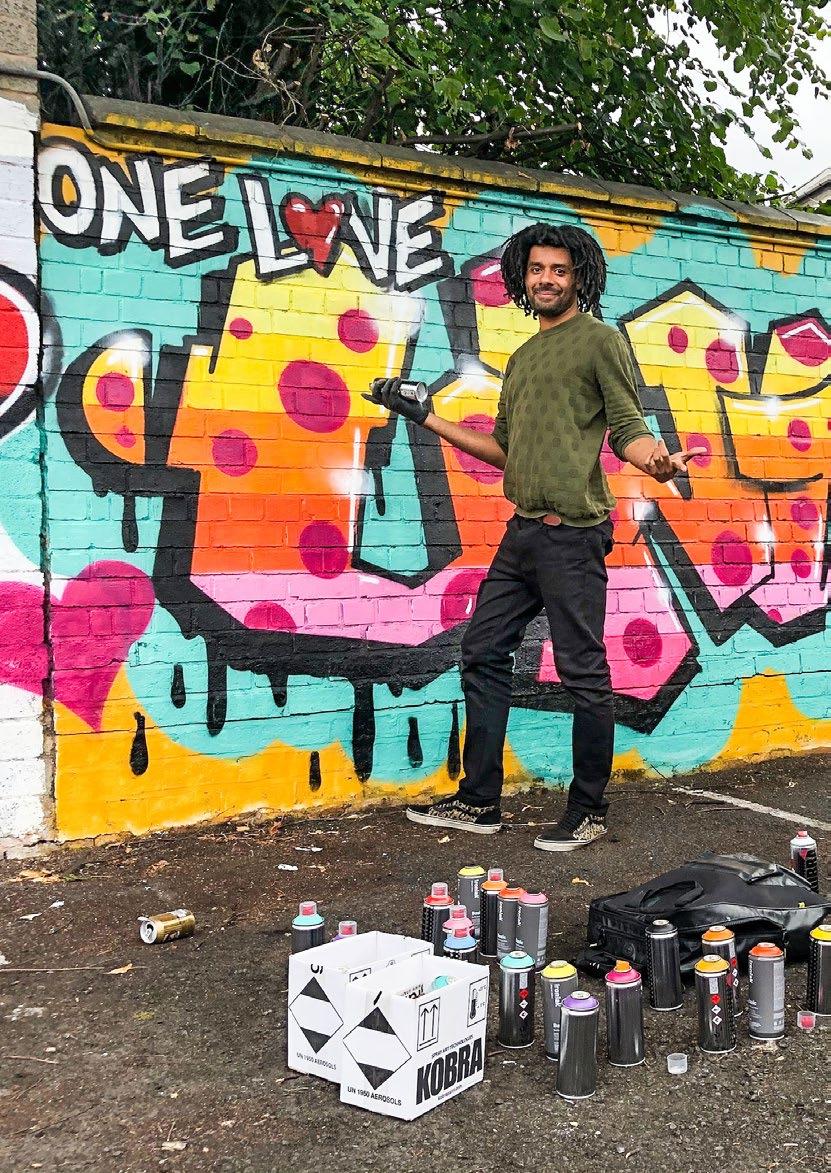
8 minute read
An interview with Marcus Barnes
Marcus Barnes Mike Patrick interviews
An Interview with Marcus Barnes: Journalist, Author and Artist.
Advertisement
In 2008, the Tate Modern opened the world’s first major public museum display of graffiti and street art, inviting six international artists to decorate its facade with enormous, eyecatching murals.
Meanwhile, at Southwark Crown Court, eight members of London’s graffiti gang known as the DPM Crew were tried for an estimated £1 million in graffiti-related damages across the country, and sentenced to a total of eleven years in prison - the biggest prosecution for graffiti in the UK to date.
I have known Marcus Barnes for a number of years. Having always impressed me with his art, he has changed my view on graffiti considerably. The interview with Marcus below gives more insight on his background and practice.
Below: “Mum”, 2019 by Marcus Barnes, Spray Paint
What is your background?
In terms of formal artistic training, I did Art at A-Level. I skipped GCSEs but managed to get onto the A-Level course on the strength of some drawings I showed the teacher - he was a bit of a maverick, so he let me on the course even though I hadn’t done Art at GCSE level. He obviously saw my potential because I got an ‘A’ and he asked me if he could keep my workbooks to show students in his new job in Spain. I went on to study a BTEC in Art & Design but quit because I found it boring.
Outside of the academic arena all my experience comes from sketching and painting in my own time. I’ve been drawing letters since I was thirteen and painting them since I was seventeen.
How have you developed your career?
Pure commitment to the artform. I’d always seen tags around where I lived in Brockley but never understood what they were or what they meant. When a schoolfriend told me they were names, or nicknames, it opened up a whole new world to me. I was hooked and started practising tags on every bit of paper I could get my hands on. Later on, when I learned about pieces (larger colourful paintings) I was even more fixated and would draw relentlessly, copying things from magazines but also trying to invent my own style. Over the past twentyone years it’s evolved and devolved in varying degrees.
What and who inspired you?
Initially it was local gangs. Although there’s a clear distinction between gangs that tag their names and people who are more connected with graffiti culture, I didn’t know that when I was a young teenager. To be perfectly honest, when growing up on a council estate the guys in gangs seemed pretty cool to me. Some of them were good at graffiti as well and there was a bit of crossover where gang members associated with actual graffiti writers.
I eventually realised that there was a distinction and that I was more drawn to graffiti culture. The writers whose tags I saw the most were the ones I was

Figure 2. Right:
Tranquility on the River Leam (June 2019) Oil on canvas board 25.5 x 30cm
inspired by. In graffiti one of the aims is to get fame through doing a lot of paintings and tags in a lot of places, and so someone might end up with their tag in every part of London. Seeing such ubiquitous coverage by one person is pretty impressive. There was a guy called Regret who was a big inspiration in that regard; he was everywhere.
Later on, when I got a hold of magazines, I was even more inspired. Everyone from UK heroes like Mode2, Stylo, DDS crew, Nema, and Morn to New York pioneers like Phase2 and Futura2000. I collected magazines, books and videos and got introduced to a whole world of writers from everywhere.
Would you call your work graffiti or writing?
I’ve always called it graffiti or writing but refer to myself as a writer - as that’s what the majority of those involved in the culture call themselves. The pioneer Phase2, who died recently, rejected the term ‘graffiti’ as it was coined by the media in order to demonise what we do. Originally, way back in the late sixties and early seventies, kids called themselves ‘writers’ - graffiti was never used. It only got adopted once the media started to report on it.
The thing about the term graffiti is that it’s a catch-all term for any kind of writing put on a surface: silly stuff on the back of toilet doors, racist and homophobic messaging, political statements and so on. What we do is way more than just writing on a surface, it is an artform based on the alphabet. Phase2 referred to it as ‘style writing’, because that’s what we do, we write our names with style. We use letters as the main subject of our art, experimenting with the alphabet, deconstructing letters

and reconstructing them in our own style. Not everyone who writes considers it an artform though; like anything in life, this culture has its own microcosm and some people define themselves as vandals whilst others called themselves ‘graffers’.
What role do you see a writer having in society?
For the most part writers simply utilise the surfaces of the city to write their names. I guess this itself might help society at large to see that our cities and towns could be a canvas for people’s work. It’s controversial as not everyone wants to see it, but then not everyone wants to see advertisements that prey on our anxieties to sell us anything from junk food to the latest iPhone. It’s important for graffiti to exist so that there remains an avenue for people to express themselves publicly, and to challenge the status quo. Some people hate tags and think they’re an eyesore, others like them- if we all liked the same thing, the world would be a very boring place.
What does your work aim to say?
It used to simply say, “Hey look, here I am!”. I like to use bright, bold colours to get people’s attention and hopefully brighten their day a little, whether they can read my piece or not.
Over the past year I’ve stopped painting my own name and have been painting the names of writers who’ve died. So, at present my work pays respect to those we’ve lost. It says: “We love you and miss you, and we’re still thinking of you”.
How do you think street art reflects current social and political issues?
Writers are not always necessarily politically motivated but the anarchistic way in which they operate is a direct counteraction to the draconian laws of our country, so you could consider it to be a political act regardless of motivation. In a time where the people that lead our country are suffocating the arts and using divisive policies to keep society fragmented, graffiti culture offers a place for people of all backgrounds to come together and explore art freely. Not every writer considers themselves an artist, but for the most part what they’re doing - using paint and colour to create striking images through letterforms - is a form of art. It’s important that countercultures such as writing exist because we should never accept the status quo, especially when it’s as restrictive, oppressive and conservative as it is right now.
What art do you enjoy the most?
From a participatory point of view, I love painting colourful letters with spray cans, sketching letters with pencil, and sometimes completing those drawings with fineliner. I also enjoy painting my signature characters on canvas - I don’t think graffiti belongs on canvas per se, but my characters can happily sit on a canvas and live a life of contentment.
As an observer, I like a lot of different art. I’m a bit of a glutton, the same with music. I find it hard to be a critic except when I really don’t like something, I’m quite upfront about it. Anything from African sculpture, south American ceramics and fabric work, Indian religious iconography and Japanese animation, through to
minimalism. Mondrian is a favourite of mine, and I love love love Matisse and studied him as part of my A-Level. Other favourites are Yayoi Kusama, Lubaina Himid, Kahlo, Picasso. I’m a huge fan of Joan Miro, Dali, Duchamp, Kasimir Malevich, Wassily Kandinsky, Steve McQueen - anyone who uses form and colour in an expressive, unusual way I would say is going to be a winner for me. I respect the old masters and I love modern art too; I could go on and on and on!
Above: “Power” 2018 Below: “StePH”, 2019 Opposite: Unity”, 2018 by Marcus Barnes Spray Paint

Where do you see writing going?
Sadly, it doesn’t seem to be progressing very much. I’m not sure what progression of the culture would even look like but social media, especially Instagram, has led to a hell of a lot of homogeny and it’s got pretty stale. There are some exceptions to that, people inspiring writers who are very talented and have a great style- but not very many in my opinion. Like a lot of countercultures, it has been sucked into the internet and become more mainstream and commercialised.
What material do you use for writing?
We use spray paint and special nozzles, mostly. There are a few paint brands that manufacture paint especially for graffiti writers, some of which even have colours named after famous writers; some of them sponsor writers, too. They include Belton, Montana, Ironlak, Loop and many more.
A lot of writers use particular types of car paint, which they can obtain from hardware or motor spares shops. The nozzles allow you to do different things, as you would with different types of paint brushes - thick lines, thin lines, fades. People who do tags will also use a variety of different markers and pens to write their names, from paint markers and metallic ones, to ones they’ve refilled with the own ink concoctions.
Questions written by Mike Patrick We would also like to thank Marcus for his correspondence!

Figure 2. Right:
Tranquility on the River Leam (June 2019) Oil on canvas board 25.5 x 30cm
Figure 4. Below: Limelight (2017) Oil on canvas board 51 x 40.5cm











